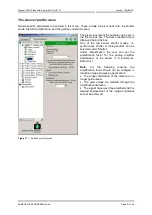
Manual: CMOS Industrial Camera LOGLUX
i5
Version 1.08 (04/07)
KAMERA WERK DRESDEN GmbH
Page 7 of 46
Upon the completion of the last integration cycle, the residual potentials of the pixels are inverted and
translated into digital numerical values.
Please note that the
multiple integration slope
mode does not work when the
rolling shutter
mode is
selected.
There are four registers (PROFILE_INIT0 / PROFILE_INIT1 / PROFILE_INIT2 / PROFILE_INIT3) that
allow the dynamic range of the IBIS5 sensor to be varied. They can be used to define both the number
of integration cycles and the integration time for the individual integration cycles. A valid integration
time is an integer number given in nanoseconds; if zero is entered in one of the above-mentioned
registers, the associated integration cycles is skipped.
Possible register settings are shown in the following examples:
This is
a typical example of the
single integration slope mode
.
The only integration cycle is carried out at the highest initial
potential in 38.885ms.
The left photo of Figure 3 was taken with this setting.
This is an example of the
multiple integration slope mode
.
The first integration cycle is run at the third largest initial potential in
200
µ
s. Thereafter, the second integration cycle is carried out at the
lowest initial potential in 10
µ
s. Because of the first ‚long‘ integration
time, evaluable residual potentials are obtained for the dark pixels,
whereas in general very low residual potentials, or none at all, are
obtained for the bright pixels. As compared with the first integration cycle, slightly lower residual
potentials are obtained for the dark pixels as a result of the second 'short' integration time, while the
bright pixels now reach evaluable residual potential levels. This register setting is, thus, suitable for
images with primarily dark regions.
Another example of the
multiple integration slope mode
.
Four integration cycles are carried out here, with the integration
times being reduced by a power of ten each, starting from 35ms.
By a clever selection of the integration time length, a dynamic
(contrast) range of >100dB in the active frame can be implemented
in four integration cycles. The right-hand photo in Figure 3 was
taken with this setting.
When taking highly dynamic images, variations of the register settings may be necessary to get
optimum results.
The following procedure is recommended for setting the register:
First a suitable exposure time - preferably that in register PROFIL_INT3 - is set for the darkest region
of the frame. Thereafter, integration cycles are added one by one, preferably starting with register
PROFIL_INT2. The integration times of all integration cycles will then be summed up to give the
previously determined optimum exposure time for the darkest image regions.
Users of the LOGLUX
LuxWare configuration tool are also recommended to apply the above
procedure. However, they have to enter the individual integration times into input fields ‚
Kneepoint
1...3
‘ instead of directly into the registers PROFILE_INT0...2, and into input field ‚
Remaining time
‘
instead of directly into PROFIL_INT3, respectively. The overall integration time (
current integration
time
) is displayed in input field ‚
Remaining time
‘.








































